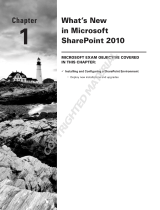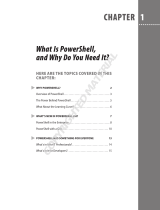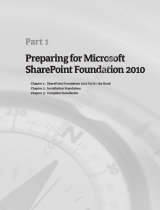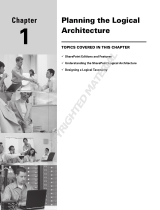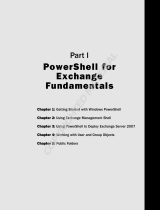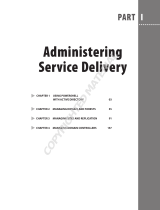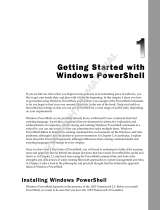Page is loading ...

1 www.microsoft.com/sharepoint
Microsoft SharePoint Server 2010
Evaluation Guide

Copyright
This is a preliminary document and may be changed substantially prior to final
commercial release of the software described herein.
The information contained in this document represents the current view of Microsoft
Corporation on the issues discussed as of the date of publication. Because Microsoft
must respond to changing market conditions, it should not be interpreted to be a
commitment on the part of Microsoft, and Microsoft cannot guarantee the accuracy of
any information presented after the date of publication.
This white paper is for informational purposes only. MICROSOFT MAKES NO
WARRANTIES, EXPRESS, IMPLIED, OR STATUTORY, AS TO THE INFORMATION IN THIS
DOCUMENT.
Complying with all applicable copyright laws is the responsibility of the user. Without
limiting the rights under copyright, no part of this document may be reproduced, stored
in, or introduced into a retrieval system, or transmitted in any form or by any means
(electronic, mechanical, photocopying, recording, or otherwise), or for any purpose,
without the express written permission of Microsoft Corporation.
Microsoft may have patents, patent applications, trademarks, copyrights, or other
intellectual property rights covering subject matter in this document. Except as expressly
provided in any written license agreement from Microsoft, the furnishing of this
document does not give you any license to these patents, trademarks, copyrights, or
other intellectual property.
Unless otherwise noted, the example companies, organizations, products, domain
names, e-mail addresses, logos, people, places, and events depicted herein are fictitious,
and no association with any real company, organization, product, domain name, e-mail
address, logo, person, place, or event is intended or should be inferred.
© 2009 Microsoft Corporation. All rights reserved.
Microsoft, Access, Active Directory, InfoPath, Internet Explorer, MS-DOS, Outlook,
PowerPoint, SharePoint, Visual Studio, Windows, Windows PowerShell, and Windows
Server are trademarks of the Microsoft group of companies.
All other trademarks are property of their respective owners.

www.microsoft.com/sharepoint
Contents
Abstract ............................................................................................................................................................. 1
Introduction .................................................................................................................................................... 1
Summary of What’s New ............................................................................................................................ 3
Governance ..................................................................................................................................................... 4
High Availability ............................................................................................................................................. 4
Deployment and Upgrade ......................................................................................................................... 4
System Requirements .............................................................................................................................. 4
Installation ................................................................................................................................................... 5
Upgrade from Office SharePoint Server 2007 ................................................................................ 6
Preparing for Upgrade ....................................................................................................................... 6
Upgrade Methods ................................................................................................................................ 7
Downtime Mitigation .......................................................................................................................... 8
Visual Upgrade ...................................................................................................................................... 8
Upgrade Logging ................................................................................................................................. 9
Upgrade Scenario ................................................................................................................................ 9
Patch Management Improvements .................................................................................................. 11
SharePoint Central Administration Web Site .................................................................................... 12
Service Applications ................................................................................................................................... 15
Search .......................................................................................................................................................... 17
Search Service ..................................................................................................................................... 18
Search Architecture ........................................................................................................................... 18
Crawling Architecture ....................................................................................................................... 18
Improving Search Performance .................................................................................................... 20
FAST Search for SharePoint ................................................................................................................. 20
Business Connectivity Services ........................................................................................................... 21
Business Data Connectivity Service Application and Model .............................................. 21

2 www.microsoft.com/sharepoint
External Content Types .................................................................................................................... 22
SharePoint Server and Office Integration ................................................................................. 22
Managed Metadata Service ................................................................................................................ 23
Managed Metadata Service Application ................................................................................... 23
Managed Metadata Service Connection ................................................................................... 24
Example Scenario ............................................................................................................................... 25
Claims-based Authentication ............................................................................................................. 25
Service Applications Conclusion ........................................................................................................ 26
Health and Monitoring.............................................................................................................................. 26
Diagnostics ................................................................................................................................................ 28
Reliability and Monitoring ................................................................................................................... 30
Remote BLOB Storage ............................................................................................................................... 31
Performance Controls ................................................................................................................................ 31
Throttling ................................................................................................................................................... 31
Controlling Large List Activities ......................................................................................................... 32
Windows PowerShell Administration ................................................................................................... 34
Cmdlets ....................................................................................................................................................... 34
Scenario: Provisioning of Managed Accounts .............................................................................. 37
Windows PowerShell Out-Performing Stsadm Scenario .......................................................... 38
Managed Accounts ..................................................................................................................................... 39
Backup and Restore ................................................................................................................................... 40
Central Administration vs. Windows PowerShell ......................................................................... 40
Granular Backup and Restore ............................................................................................................. 41
Back Up a Site Collection ................................................................................................................ 41
Export a Site or List ............................................................................................................................ 42
Recover Data from an Unattached Content Database ......................................................... 43
Scenario: Using Windows PowerShell to Script Backing Up All Site Collections
Individually ........................................................................................................................................... 45

3 www.microsoft.com/sharepoint
Farm Backup and Restore .................................................................................................................... 45
Read-Only Databases ............................................................................................................................ 45
SQL Mirroring ........................................................................................................................................... 46
SQL Snapshots ......................................................................................................................................... 47
Search and Index Backup and Restore ............................................................................................ 47
Multi-tenancy and Hosting ...................................................................................................................... 47
Site Subscriptions.................................................................................................................................... 47
Administration.......................................................................................................................................... 48
Branding ......................................................................................................................................................... 49
Themes........................................................................................................................................................ 49
SharePoint Designer .............................................................................................................................. 50
Master Pages ............................................................................................................................................ 51
Silverlight ................................................................................................................................................... 52
Conclusion ..................................................................................................................................................... 52

1 www.microsoft.com/sharepoint
Abstract
This evaluation guide is designed to give the IT pro an introduction and overview of the
features in Microsoft® SharePoint® Server 2010 Beta that are most pertinent to
installing, managing, and configuring the SharePoint farm. It begins with a brief
introduction and a summary of what’s new, followed by a more in-depth discussion of
the most relevant features.
The ultimate goal of this guide is to provide the IT pro with the understanding necessary
for installing and evaluating SharePoint Server 2010. This guide is intended for the
Windows Server® administrator, Office SharePoint Server 2007 administrator, Web
server administrator, or any IT pro involved in server administration.
This evaluation guide is subject to change. For the latest information about SharePoint
Server 2010, go to http://www.microsoft.com/sharepoint.
Introduction
Welcome to the IT pro's Microsoft® SharePoint® Server 2010 Evaluation Guide. The goal
of this guide is to help you gain sufficient knowledge and understanding to evaluate this
product from Microsoft.
SharePoint Server 2010 is the business collaboration platform for the enterprise and the
Web. The platform empowers people and enables them to connect through an
integrated set of rich features. This common collaboration environment provides a
unified infrastructure, which helps organizations cut costs while allowing them to rapidly
respond to business needs. SharePoint Server 2010 can be deployed onsite (also called
on-premises) or as hosted services, and can be deployed by using virtualization
technology or live instances. Whether on-premises or hosted, deploying SharePoint
Server requires the IT pro to be heavily involved. Microsoft SharePoint Server 2010
includes a large number of improvements to features that the administrator is familiar
with, and it also includes many new features.
Specifically, SharePoint Server 2010 provides the IT pro with:
• IT pro productivity by improving the administrative experience and by giving
the administrator deeper operational insight. This increase in productivity is

2 www.microsoft.com/sharepoint
facilitated by a new, streamlined Central Administration Web site, new capabilities
to manage and monitor the SharePoint farm, and Windows PowerShell™ support,
just to name a few features.
• Scalable unified infrastructure that includes better control over server
resources (for example, to improve the performance and management of large
lists) and data management and protection by using high availability. We have
also introduced a new scalable services architecture that allows you to effectively
manage and centralize services like Search, My Sites, and Taxonomy. These
service applications can be managed through Central Administration, and they
can be managed and scripted by using Windows PowerShell as well. The new
services architecture is extensible, so third-party companies can build services
and add them to the platform.
• Flexible deployment by providing a quick and simple installation and
configuration process. The upgrade from Office SharePoint Server 2007 is smooth
and predictable. We’ve also introduced functionality that allows you to manage
how your users use SharePoint. For example, you can now safely allow site
administrators to upload custom user code by using Sandboxed Solutions. You
also have more governance control: If you want to maintain a centralized
SharePoint deployment versus a more decentralized approach, you can either
block those deployments through Group Policy or track them by using Active
Directory® marker support.
SharePoint Server 2010 provides a very large number of features, and a detailed
accounting of each feature is well beyond the scope of this document. This guide will
describe some of the most compelling improvements and new additions to the
SharePoint Server 2010 platform for IT pros. With this evaluation guide, the IT pro will
be able to properly evaluate these new features and readily describe their capabilities to
their colleagues, clients, and business partners.
Next, we will briefly discuss a summary of the new features, followed by a brief summary
of how these features can be used to achieve functions such as governance and high
availability. Then we will move on to the details of each of the pertinent features.

3 www.microsoft.com/sharepoint
Summary of What’s New
Microsoft® SharePoint® Server 2010 includes numerous new capabilities and features
only some of which are highlighted in this guide. Here is a brief summary of what’s new.
IT pro productivity
SharePoint Best Practices Analyzer
Backup and restore configuration data
Site collection migration
Content recovery down to the site and list level
Content restore of site or list
Windows PowerShell™ snap-ins and commands
Scalable unified infrastructure
Shared service applications
Hosting and multi-tenancy architecture with site subscriptions
Claims-based authentication
Profile synchronization
High availability automatic failover
Content type syndication
Sandbox solutions
Policy
Flexible deployment
Prerequisite installer
Visual Upgrade
Configuration wizards
Scriptable deployment
On-premise or online
Before we begin the discussion of each of the features, let’s briefly mention how these
features can be used to provide governance, a very key topic for IT pros.

4 www.microsoft.com/sharepoint
Governance
Governance in Microsoft® SharePoint® Server 2010 is the set of roles, responsibilities,
and processes that you put in place in an enterprise to guide the development and use
of a solution based on SharePoint Server. There are several new features in SharePoint
Server that help the IT pro deliver governance: metadata creation and management,
shared service applications, taxonomy, multi-tenancy, sandbox solutions, content type
syndication, and policy. These topics are discussed in greater detail in the guide but it is
worth mentioning them now because it is important to realize how features in
SharePoint Server can provide solutions. Solutions generally utilize several features
together, and it is easy to overlook the solution capability when discussing features
individually. Another very important solution is high availability. This is discussed in the
next section.
High Availability
Several feature improvements targeted at the database level and the search service help
achieve high-availability architecture. Microsoft® SharePoint® Server 2010 leverages
the underlying Microsoft SQL Server™ high- availability technologies such as log
shipping, snapshots, and database mirroring, and now includes automatic failover. Other
features such as read-only content databases, unattached database backup and restore,
and configuration database backup and restore provide much more granular control
and manageability of the SharePoint farm’s data. Now it’s time to discuss some of
features beginning with SharePoint deployment and upgrading from Office SharePoint
Server 2007.
Deployment and Upgrade
System Requirements
As one would imagine, a powerful application such as this requires a server environment
capable of supporting it. As such, the requirements for your infrastructure will draw
upon the latest server and application technologies. To implement a Microsoft®
SharePoint® Server 2010 environment, your infrastructure must leverage the following
minimum requirements:

5 www.microsoft.com/sharepoint
• Microsoft Windows Server® 2008 64-bit operating system with Service Pack 2
(SP2) or later OR Windows Server 2008 R2
• Microsoft SQL Server™ 2005 64-bit with SP2 or later or SQL Server 2008 64-bit
• Microsoft .NET Framework 3.5 with SP1 installed
Level 1 Internet browser options running on the Windows® operating system:
• Windows Internet Explorer® 7 32-bit
• Internet Explorer 8 32-bit
• Firefox 3.x 32-bit
Level 2 Internet browsers options:
• Internet Explorer 7 64-bit
• Internet Explorer 8 64-bit
• Firefox 3.x on non Windows operating system
• Safari 3.x
For the complete and updated list of prerequisites for installing SharePoint Server 2010,
see "Determine hardware and software requirements (SharePoint Server 2010)"
(http://go.microsoft.com/fwlink/?LinkId=166546) on the Microsoft TechNet Web site.
Installation
For administrators who have previously installed SharePoint Server, the installation
options for SharePoint Server 2010 will be familiar. In fact, a number of enhancements
help make the installation process easy for all users. To start, Microsoft has added the
prerequisite installer. Before installing SharePoint Server 2010, run the prerequisite
installer and it will scan the system to ensure that all of the components required to
deploy SharePoint (Internet Information Services, .NET Framework, and so on) have been
installed. If they haven’t, the prerequisite installer will download and install the
components needed for the SharePoint Server 2010 installation. Optionally, you can
specify that the installer pull files from a local path to avoid the trip to the Internet.
After the prerequisite components have been installed, you have two options for
installing SharePoint Server 2010: use the graphical user interface (GUI) or script the
installation by using configuration files and Windows PowerShell™. The GUI provides a
simple step-by-step process where users can specify the configuration they want. Using
Windows PowerShell is a bit more involved, but in the end it usually proves to be the

6 www.microsoft.com/sharepoint
better choice. By scripting the installation, you can ensure that all of your servers
running SharePoint Server have identical configurations. Scripted installations are also
advantageous from a disaster recovery perspective. If a server goes down, you can
reinstall SharePoint Server quickly by using a previously created script. Both methods
are fully supported.
Another new aspect of the installation process is the addition of a farm passphrase. This
is a password that is used to encrypt all communications across the farm. The farm
passphrase is required before you can remove a server from the SharePoint farm or add
a server to the farm. The passphrase can be changed through Windows PowerShell by
the administrator.
Other changes allow network administrators to organize and manage servers running
SharePoint Server on the network. Active Directory® markers make it possible to add
new servers running SharePoint Server to an organizational unit (OU) in Active Directory
when they are installed on the network. This makes it easier for network administrators
to keep track of all servers running SharePoint Server within their domain.
Administrators can use Group Policy to manage farm proliferation on the network, for
example to prevent SharePoint from being installed on unauthorized servers. This gives
administrators tighter control over the SharePoint environment and increases their
ability to enforce governance policies.
Upgrade from Office SharePoint Server 2007
So many people have invested so much in Office SharePoint Server 2007 — the same
level of investment has been made in upgrade processes and strategies for moving to
SharePoint Server 2010. These investments were made in all phases, from preparing to
upgrade to customizing the post-upgrade environment.
Preparing for Upgrade
The first investment was released in Office SharePoint Server 2007 Service Pack 2, with
the addition of the Stsadm.exe operation, preupgradecheck. This operation can be run
on your Office SharePoint Server 2007 farm to report on farm and server data. It will
identify key information, such as:
• Servers and total amount of content
• Search configuration
• Alternate access mappings

7 www.microsoft.com/sharepoint
• Features
• Site definitions
• Language packs
It will also expose potential issues, including:
• Large lists
• Data orphans
• CAML views and CAML content types
• Modified content databases that have improper schemas
• Missing upgrade dependencies
All of this information will be collected and then output into an .htm file you can view
from your browser. This process is read-only. It does not change your environment, so
you can run it often, not only before upgrading but also just to check the general health
of your environment. Any automatic fixing of your environment will occur at upgrade
time and not during pre-upgrade scanning.
If you are already running SharePoint Server 2010 and would like to check whether your
content databases are Office SharePoint Server 2007 or SharePoint Server 2010
databases, you can use a Windows PowerShell cmdlet. The cmdlet Test-
SPContentDatabase can be run against the databases of either version. It will test a
specific database referenced against a specific Web application. It identifies current or
potential issues, such as:
• Data orphans
• Missing site definitions
• Missing features
• Missing assemblies
This cmdlet is meant to complement the pre-upgrade checker report and is also read-
only, preventing any disruption of your data while you are testing for issues.
Upgrade Methods
There are two primary methods for upgrading from Office SharePoint Server 2007 to
SharePoint Server 2010: in-place and database attach. The in-place method is used to
upgrade an existing Office SharePoint Server 2007 server to SharePoint Server 2010, and
the process can be restarted as necessary if issues arise. While the database attach

8 www.microsoft.com/sharepoint
method would allow you to backup a Office SharePoint Server 2007 database and attach
it to your SharePoint Server 2010 Web application, SharePoint Server would then
upgrade this database and make it available through the Web application. Additionally
there is support for single click installations to be upgraded by using in-place upgrade,
and then migrated from a Windows Internal Database deployment to take advantage of
remote BLOB storage (RBS, covered later in this guide).
Downtime Mitigation
Several features have been introduced in SharePoint Server 2010 to allow for upgrade to
occur with little to no outages and at the same time to allow for quicker upgrade
windows.
The first feature is the use of read-only databases, which was made available starting
with Office SharePoint Server 2007 Service Pack 2. SharePoint Server 2010 now
recognizes a content database has been made read-only from within SQL Server and will
trim the user interface as if all site collections were marked read-only. This allows users
read access to the content while the upgrade takes place.
Another advancement to reduce the amount of time an upgrade will take is that
SharePoint Server 2010 supports performing several database attach upgrades at the
same time. Through the use of multiple Windows PowerShell sessions, multiple
databases are upgraded. which means the amount of data upgraded at one time is
limited only by your SQL Server resources.
Finally, for customers who have such extreme amounts of content that completing the
upgrade within a reasonable window is not possible, there is another option. This option
involves using alternate access mapping redirections to direct traffic between a
SharePoint Server 2010 farm and Office SharePoint Server 2007 farm based on the
requested URL by using client-side 302 redirects.
Visual Upgrade
To mitigate the impact of the upgrade on the user community, SharePoint Server 2010
supports Office SharePoint Server 2007 master pages and cascading style sheets. By
default, after a content database is upgraded, the sites will be displayed with the Office
SharePoint Server 2007 visuals, giving the user their familiar look and feel. An upgraded
site can then exist in one of three states: Office SharePoint Server 2007, SharePoint
Server 2010 preview mode, and SharePoint Server 2010. This allows the site

9 www.microsoft.com/sharepoint
administrator to preview how the site looks with the SharePoint Server 2010 user
interface before committing to it. This setting is at the site level, allowing for a very
granular, flexible experience.
Figure 1: Visual Upgrade Options
Upgrade Logging
The logging capabilities have been expanded and standardized, allowing for easier,
more consistent reporting on the upgrade process. This includes the creation of a
unique log for each upgrade. Also, an errors-only log is generated, which reduces the
need to look through the full logs to discover issues.
Upgrade Scenario
To better understand the upgrade process, consider the following scenario. Randy has
been tasked with upgrading his Office SharePoint Server 2007 farm to SharePoint Server
2010 while incurring as little downtime as possible. It will be acceptable for the data to
be read-only during the upgrade. Randy will be deploying SharePoint Server 2010 on
new hardware and will be performing the upgrade by using the database attach
method.
To begin the process, Randy has tested and updated the server running Office
SharePoint Server 2007 with Service Pack 2 and all applicable cumulative updates. Now
he can run Stsadm.exe –o preupgradecheck. He uses the output to verify that his farm

10 www.microsoft.com/sharepoint
is ready to be upgraded. He does discover some issues where he is not following
SharePoint best practices around large lists, and is able to examine the list and find
solutions. Because preupgradecheck is a read-only tool, it is safe for him to run it often,
confirming his progress as he works to mitigate the issues that have been raised.
Now that Randy has his databases in good shape, he begins building SharePoint Server
2010 on his new hardware. After he has established this farm, configured all necessary
service applications, and provisioned his required Web applications, he can begin the
process of testing upgrade. Because he has chosen the database attach method, he
performs a backup of his database from production and restores it to his new computer
running SQL Server. On this SQL Server, he takes advantage of the Windows PowerShell
cmdlet Test-SPContentDatabase to report any potential issues with attaching the
content database to his newly provisioned Web application. From the output of this
command he finds he has not installed all of the necessary Features on his new server.
He is now able to install the necessary Features avoiding a failed upgrade.
With all of the necessary pieces now in place, Randy performs his first upgrade by using
the Windows PowerShell cmdlet Upgrade-SPContentDatabase. After the upgrade
concludes, he reviews the errors-only upgrade log and then the full upgrade log, which
gives him both a focused picture of any issues that occurred and the line-by-line story
that he can review to get a better understanding of what happened during the upgrade
process.
With the upgrade cmdlet successfully completed , he now can open the site and review
his content. The first thing he notices is that his site looks exactly as it did in the Office
SharePoint Server 2007 farm, thanks to the Visual Upgrade features. To see what his site
will look like with the SharePoint Server 2010 look and feel, he goes into Site Settings
and selects the preview option. This gives Randy the opportunity to confirm that
everything looks appropriate with the new visuals applied. If he is happy with the results,
he can make the change permanent; if he feels he will need to make adjustments to the
site, he can turn preview off and return to the Office SharePoint Server 2007 interface.
The feature is set at the individual site level, allowing Randy to make very granular
choices. He can also use Windows PowerShell to script the changing of the visuals.
After Randy finishes working with the various business content owners to validate the
upgrade process and works through any issues, he is ready to plan his production
upgrade schedule. His plan is to notify his users and then take his Office SharePoint

11 www.microsoft.com/sharepoint
Server 2007 farm and set all of the content database to read-only from within SQL
Server. Not only will this set the data to read-only, preventing any data inconsistency
during the upgrade window, it will trim the user interface by taking away New or Edit
functionality for all users, which helps avoid confusion. After all databases are read-only,
Randy will perform a backup of the databases and restore them to his new computer
running SQL Server. With the databases in-place he can then begin attaching the
databases by using Windows PowerShell. During testing, he confirmed his hardware was
powerful enough that he could open multiple Windows PowerShell windows, each one
upgrading a different database, all at the same time. This allowed him to shorten his
upgrade window.
With all of his company’s SharePoint content upgraded and available, Randy then had
DNS updated to resolve all of his Web applications to the new farm. His content owners
then confirmed the production upgrade was successful and switched their visuals to
SharePoint Server 2010 as appropriate. Each content owner had previously determined
the necessary course of action for moving to the new visuals and the time frame for
making the change. Randy has set a hard date of 30 days before he will use Windows
PowerShell to force all visuals to the SharePoint Server 2010 look and feel.
Randy has had a very successful upgrade to SharePoint Server 2010 thanks to his using
out-of-the-box SharePoint tools and performing lots of planning and testing. Because
he worked out the kinks throughout the testing phase, he was able to accomplish the
upgrade with minimal impact on his business users.
Patch Management Improvements
While upgrade is used to move from version to version, updating (also called
"patching") uses the same principles to move from build to build. To allow control and
flexibility of the update process, several capabilities are available. The update
management user interface and update reporting cmdlet allow for the monitoring of
updates throughout the farm. There are also update status health rules that will alert an
administrator to inconsistencies. To allow for more flexibility while applying updates in
farm scenarios, SharePoint Server 2010 supports backward compatibility of updates. This
will permit an administrator to apply updates to the servers in the farm without applying
the updates to the databases for a temporary period. This allows the scheduling of
downtime for the database upgrade portion of the update, or the use of the downtime

12 www.microsoft.com/sharepoint
mitigation technique of using a read-only database to avoid an outage while rolling in
updates.
SharePoint Central Administration Web Site
The Central Administration Web site has been redesigned in Microsoft® SharePoint®
Server 2010 to provide a more familiar experience and make it easier for users to find
what they are looking for. The home page for Central Administration groups major
functional areas together and lists many of the most common tasks. Each of the major
areas (Application Management, Monitoring, and so on) is represented on the Home
page and can be accessed by clicking its name or by clicking the corresponding link
from the navigation at the left side of the page.
Figure 2: Central Administration
Although the user interface has changed slightly, users will find many of the menus to
be familiar, with some new available options and functionality. One of the places where
this is more obvious has to do with how Web applications are managed. Web
applications are still created by following the same process, but the process is now
managed through a ribbon interface on the Manage Web Applications page. The ribbon
makes it easier for users to view or change details about a Web application by supplying
all the options so they are one click away. In Office SharePoint Server 2007, many of
these tasks required the user to click a different menu and reselect the Web application

13 www.microsoft.com/sharepoint
each time. Now, users simply select the Web application and then all of the options for
managing the Web application can be accessed by a single click.
Figure 3: Ribbon Interface
In addition to the more obvious changes to the user interface, there are several new
pieces of functionality hiding among the menus. As you can see in the screenshot of the
Central Administration home page, a new page named Configuration Wizards has been
added. Wizards are designed make the configuration process easier by guiding users
through the steps to configure functionality.
Figure 4: Configuration Wizards page
The Farm Configuration Wizard is available by default. This wizard takes users through
the process of specifying the accounts that each service will run under. It is possible for
additional wizards to be added by third-party vendors or by developers to assist with
configuring other areas of SharePoint Server 2010.
Clicking the Backup and Restore link displays another new set of features. Previously the
ability to perform granular backups such as backing up a site collection, site, or list was
only possible by using the Stsadm command line tool. New in SharePoint Server 2010 is
the ability to perform these granular backups directly from the Backup and Restore page
in Central Administration.

14 www.microsoft.com/sharepoint
Figure 5: Backup and Restore Page
A complete disaster recovery plan not only includes the ability to restore servers and
databases but also how to recover smaller units of data like a single document. In the
past, this scenario proved problematic — recovering a single file often required an
administrator to restore an entire content database to a separate SharePoint farm.
Moving whole databases around and restoring them to new farms was a lot of work to
recover a small amount of data. SharePoint Server 2010 has added the ability to recover
data from an unattached content database. In other words, if you need to restore data
from a backed-up content database, you can browse the content of that content
database as long as it is attached to a computer running SQL Server, even if it is not
necessarily associated with SharePoint Server. Administrators can browse the content
database, back up a site collection, or export a site or list. After the content has been
located and saved into a separate location, it can quickly be restored to the production
database. The new backup and restore functionality will be covered in more detail later
in this guide.

15 www.microsoft.com/sharepoint
Figure 6: Connect to a content database
The security model in SharePoint Server 2010 has been expanded to allow
administrators more control over the management of service applications. In Office
SharePoint Server 2007, farm administrators had the ability to manage services on the
server. Farm administrators can now click a service application and be presented with
several options for managing the service, including specifying administrators for the
service and setting permissions. Service applications will be covered in more detail later
in this guide.
Service Applications
Microsoft® SharePoint® Server 2010 implements a new, more flexible shared service
model compared to its predecessor, Office SharePoint Server 2007. This new model is
referred to as service applications. The service application architecture is now also built
into Microsoft SharePoint Foundation 2010, in contrast to the Shared Services Provider
(SSP) architecture that was only part of Office SharePoint Server 2007. A key benefit here
is that all services are installed by default and there is no SSP setup. The figure below
shows the Applications Management page in Central Administration, illustrating the
Service Applications option.
/
